Classic Yosemite images in black and white: explore the national park captured in monochromatic photos (updated 2023)
“A great photograph is one that fully expresses what one feels, in the deepest sense, about what is being photographed.”
― Ansel Adams
Capturing Yosemite images in black and white
Whenever anyone thinks of Yosemite, Ansel Adams and his striking black and white images immediately come into mind. Even with so many talented artists, photographers and creative people visiting and dedicating their craft to this magnificent national park, it is Ansel’s work that is immediately recognized and symbolic of the natural beauty and stunning magnificence of Yosemite.
Why is capturing the landscape of Yosemite in black and white different?
Capturing the landscape of Yosemite in black and white offers a unique and compelling perspective for several reasons:
1. **Timelessness:** Black and white photography can convey a sense of timelessness. Yosemite’s natural beauty, unchanged over centuries, harmonizes beautifully with the classic and timeless feel of monochromatic imagery.
2. **Simplicity:** Stripping away color simplifies the image, allowing viewers to focus on the fundamental elements of composition, light, and form. In Yosemite, this simplicity accentuates the grandeur of the landscape.
3. **Texture and Contrast:** Black and white photography accentuates textures and contrasts. The rugged cliffs, cascading waterfalls, and intricate details of Yosemite’s terrain become even more pronounced, adding depth and drama to the images.
4. **Emotional Impact:** The absence of color can evoke powerful emotions. Yosemite’s awe-inspiring vistas and serene moments are often heightened when portrayed in black and white, inviting viewers to connect with the landscape on a deeper level.
5. **Artistic Expression:** Many photographers are drawn to black and white for its artistic potential. Yosemite’s diverse landscapes provide ample opportunities for creative expression, allowing photographers to craft images that convey their unique vision.
6. **Historical Tribute:** Yosemite has a rich history, and black and white photography pays homage to the park’s early photographers like Ansel Adams, who famously captured its beauty in monochrome. It’s a way to connect with the park’s photographic heritage.
7. **Storytelling:** Black and white images can be particularly effective for storytelling. They invite viewers to explore the composition, light, and details, creating a narrative that goes beyond color.
In essence, capturing Yosemite in black and white is a choice that transforms the familiar into something fresh and evocative. It invites us to see the park’s iconic landscapes through a different lens, appreciating its timeless beauty and artistic potential in a new light.
Landscape photography in Yosemite
The challenge of visiting Yosemite for the casual and more serious photographer is to capture the essence of Yosemite and create images that are unique, represent your own creativity, perspective and composition. The challenge to photographing these iconic sites is to go above and beyond the mundane and typical presentation and often leading to disappointment – as Ansel states in his quote above ‘ Often the supreme disappointment’. It is only the person who tries to go beyond convention, experiments and takes the time to view and see the landscape – then they will truly find something that inspires and offers a unique vision and image.
“Landscape photography is the supreme test of the photographer – and often the supreme disappointment. ”
― Ansel Adams
What are the most scenic spots of Yosemite to photograph?
Yosemite National Park is a photographer’s paradise, offering an array of stunning scenic spots to capture its natural beauty. Here are some of the most scenic spots to photograph in Yosemite:
Tunnel View:
This iconic viewpoint along Wawona Road offers a breathtaking panoramic view of Yosemite Valley, including El Capitan, Half Dome, and Bridalveil Fall. It’s especially spectacular during sunrise and sunset.
Glacier Point:
Accessible in the summer months, Glacier Point provides a high vantage point overlooking Yosemite Valley. The sweeping views of Half Dome and the High Sierra peaks are perfect for both day and nighttime photography.
Valley View:
Located near El Capitan Meadow, Valley View offers a classic view of El Capitan with the Merced River in the foreground. It’s an ideal spot for sunrise and late afternoon shots.
Yosemite Falls:
This iconic waterfall is the tallest in North America. Capture it from various viewpoints, such as Cook’s Meadow, Lower Yosemite Fall Trail, or Sentinel Bridge. The play of light and mist adds drama to your photos.
Bridalveil Fall:
Photograph this elegant waterfall from the meadows near its base. Early morning or late afternoon light can create beautiful rainbows in the mist.
Cathedral Beach:
This area along the Merced River offers reflections of Cathedral Rocks and El Capitan. Visit during sunrise or sunset for magical mirror-like reflections.
Mirror Lake:
During the spring and early summer, Mirror Lake reflects the surrounding cliffs, including Half Dome. The calm waters make for great reflection shots.
Olmsted Point:
Located along Tioga Road, Olmsted Point provides stunning views of the park’s high country, including Clouds Rest and Half Dome. The jagged granite landscape is especially photogenic.
Tenaya Lake:
This pristine alpine lake along Tioga Road is surrounded by granite peaks. The clear waters and dramatic backdrop make it an excellent location for landscape photography.
Tuolumne Meadows:
In the high country, Tuolumne Meadows offers expansive meadows, the winding Tuolumne River, and views of the Cathedral Range. It’s a serene location for capturing the park’s natural beauty.
11. **Mariposa Grove of Giant Sequoias:** Photograph these massive trees, including the famous Grizzly Giant and California Tunnel Tree, in the soft morning light.
12. **Highway 120 Viewpoints:** As you drive into the park on Highway 120, numerous turnouts provide stunning vistas of Yosemite Valley from a distance. These are great for capturing the grandeur of the entire valley.
Remember that Yosemite’s beauty changes with the seasons, so the best time for photography may vary. Sunrise and sunset are typically ideal times for capturing the park’s magical ambiance, but don’t hesitate to explore during different times of the day to discover unique perspectives and lighting conditions.
Perspective
“You don’t take a photograph, you make it.”
― Ansel Adams
This last quote that Ansel states is quite relevant for todays photographer and the many tools they use. Ansel was the great experimenter with his equipment and also a master manipulator in the dark room. He really worked hard to capture images that were well composed, maximized seasonality, location and incredible natural lighting conditions. He also spent a lot of time in the dark room (or his associates) manipulating images to represent nature at its best. It would be no surprise to most photographers that Ansel excelled at camera and dark-room techniques to make the absolute best representation of his work. Even today, creating magnificent landscapes entails many levels of learning, honing camera techniques and crafting, along with mastering software/dark room technologies to highlight the natural beauty of an image.
Weather and best time to visit Yosemite
The weather in Yosemite National Park varies significantly depending on the season and the elevation. Here’s a breakdown of the best times to visit Yosemite based on the seasons:
Spring (March to May):
– **Weather:** Spring brings mild temperatures, but higher elevations may still have snow. Valley temperatures range from 50°F to 70°F (10°C to 21°C), while higher elevations are cooler.
– **Scenery:** Waterfalls are at their peak flow during late spring, creating stunning photo opportunities. Wildflowers begin to bloom, adding color to the landscapes.
Summer (June to August):
– **Weather:** Summer is the peak tourist season, with warm days in the valley (70°F to 90°F or 21°C to 32°C) and cooler temperatures at higher elevations. Evenings are pleasant.
– **Scenery:** The park is at its greenest, and all areas are accessible. Popular spots can be crowded, but you’ll enjoy long daylight hours for photography.
Fall (September to November):
– **Weather:** Fall is a fantastic time to visit with mild temperatures in the valley (50°F to 80°F or 10°C to 27°C). Higher elevations begin to see snow.
– **Scenery:** Fall foliage is a highlight, especially in Yosemite Valley. The park’s waterfalls can slow down, but the autumn colors are a photographer’s dream.
Winter (December to February):
– **Weather:** Winter brings snow to the valley, creating a serene and less crowded atmosphere. Daytime temperatures range from 30°F to 50°F (-1°C to 10°C), while higher elevations have heavy snowfall.
– **Scenery:** Yosemite becomes a winter wonderland, offering unique photo opportunities. Frozen waterfalls and snowy landscapes are captivating.
For photographers, the best times to visit are spring for waterfalls, fall for vibrant foliage, and winter for a snowy wonderland. However, each season offers its own charm, so the choice depends on your photographic preferences and tolerance for crowds and weather conditions. Keep in mind that weather can vary, so check forecasts before your trip and be prepared for changing conditions.
More inside tips to capturing Yosemite in black and white
Capturing the landscape of Yosemite in black and white offers a unique and compelling perspective for several reasons:
1. **Timelessness:** Black and white photography can convey a sense of timelessness. Yosemite’s natural beauty, unchanged over centuries, harmonizes beautifully with the classic and timeless feel of monochromatic imagery.
2. **Simplicity:** Stripping away color simplifies the image, allowing viewers to focus on the fundamental elements of composition, light, and form. In Yosemite, this simplicity accentuates the grandeur of the landscape.
3. **Texture and Contrast:** Black and white photography accentuates textures and contrasts. The rugged cliffs, cascading waterfalls, and intricate details of Yosemite’s terrain become even more pronounced, adding depth and drama to the images.
4. **Emotional Impact:** The absence of color can evoke powerful emotions. Yosemite’s awe-inspiring vistas and serene moments are often heightened when portrayed in black and white, inviting viewers to connect with the landscape on a deeper level.
5. **Artistic Expression:** Many photographers are drawn to black and white for its artistic potential. Yosemite’s diverse landscapes provide ample opportunities for creative expression, allowing photographers to craft images that convey their unique vision.
6. **Historical Tribute:** Yosemite has a rich history, and black and white photography pays homage to the park’s early photographers like Ansel Adams, who famously captured its beauty in monochrome. It’s a way to connect with the park’s photographic heritage.
7. **Storytelling:** Black and white images can be particularly effective for storytelling. They invite viewers to explore the composition, light, and details, creating a narrative that goes beyond color.
In essence, capturing Yosemite in black and white is a choice that transforms the familiar into something fresh and evocative. It invites us to see the park’s iconic landscapes through a different lens, appreciating its timeless beauty and artistic potential in a new light.
Ansel Adams Art Gallery
One of my favorite stops in Yosemite is to visit the Ansel Adams Gallery in Yosemite Village and seeing any of the new exhibits. Hosting iconic and historic photographers and their contemporaries, this gallery is a must visit for any photographer. Along with enjoying some of the current exhibits, it’s a great place to get information on scenic places to photograph around the park, photo workshops and guides in the park and viewing some of the masterpieces of Ansel Adams work on display. To get more information about current events, shows and workshops, visit the Ansel Adams gallery website here.
Where to stay in Yosemite
There are many options in visiting the area either if you stay in the valley, camp or just outside in the smaller communities leading up to the national park. Places do book up early during the visiting season, so plan well ahead for your visit and book in advanced. Here are some suggestions on where to stay in the area.
Yosemite View Lodge – located in El Portal just on the outside of the park entrance, with large rooms overlooking the river, large baths with Jacuzzi, friendly service and park shuttles.
The Majestic Yosemite Hotel – called Awhanee before this classic national park hotel is stunning and with period details and modern amenities.
Yosemite Valley Lodge – centrally located in the park village area with plenty of choices to dine and shop in the village, clean rooms and pick up for shuttle service.
Half Dome Village – Camping accommodation set up close to Half Dome – if you want to experience camping with heat, bedding supplies and bathroom services close by without the hassle of slepping stuff.
For more reviews of places to stay around Yosemite, check out this link for current prices and availability.
Check out these other posts on visiting Yosemite National Park
Yosemite history and indian culture
Yosemite key attractions and landscapes
A scenic hike to Glacier Point
Awhanee Hotel visit and brunch
Hetch Hetchy reservoir and dam
Conclusion to capturing Yosemite in Black and White
Capturing Yosemite in black and white photography is a journey through contrasting landscapes, timeless granite monoliths, and the interplay of light and shadow. This artistic choice transforms this iconic national park into a realm of classic elegance and drama.
From the towering presence of El Capitan to the ethereal mist of Bridalveil Fall, Yosemite’s landmarks take on a new character in black and white, inviting viewers to appreciate the raw essence of nature. The monochromatic palette allows photographers to emphasize texture, form, and the intricate details of the park’s flora and fauna.
Whether you’re exploring the grandeur of Tunnel View, the serenity of Mirror Lake, or the enchanting reflections of Cathedral Beach, Yosemite’s diverse landscapes offer endless opportunities for captivating black and white compositions. The ever-changing weather and seasons add depth and variety to your photographic adventures.
In your pursuit of timeless imagery, remember to experiment with different angles, exposure settings, and post-processing techniques to bring out the unique qualities of Yosemite in black and white. Ultimately, Yosemite’s beauty transcends color, and capturing it in monochrome allows you to share a different, yet equally captivating, perspective with the world.
If you like this post on Yosemite Photos – key attractions and landscapes, please consider subscribing to the blog by email below for updates – also ‘like’ my Facebook page on the sidebar, I show more images, tips and inspiration on my Facebook page, come and visit!
If you like what you see, come and check out my other social media channels for more updates, including Instagram, Pinterest and Twitter
Disclosure – There are affiliates links on this posts which provide a small commission to support this site at no extra cost to you. Thank you for reading.


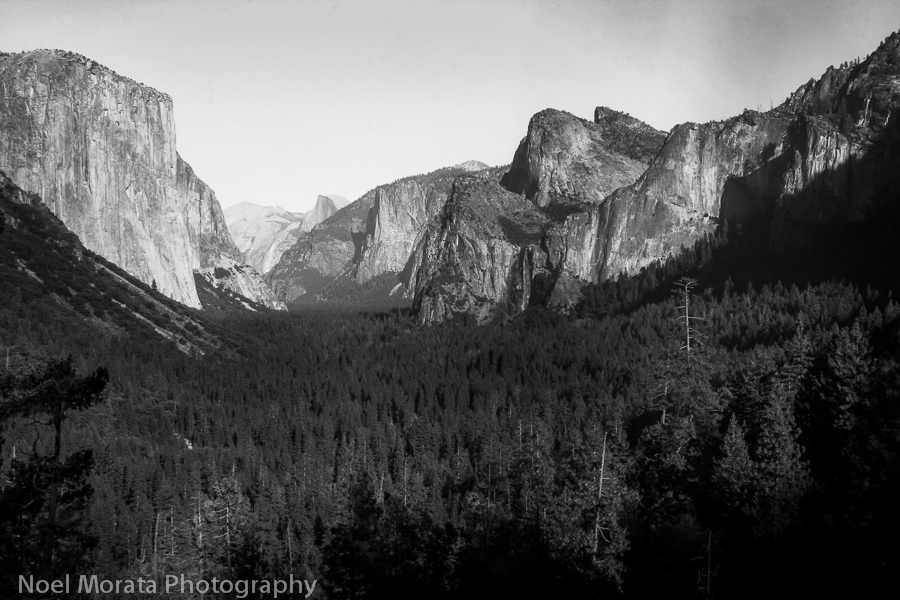


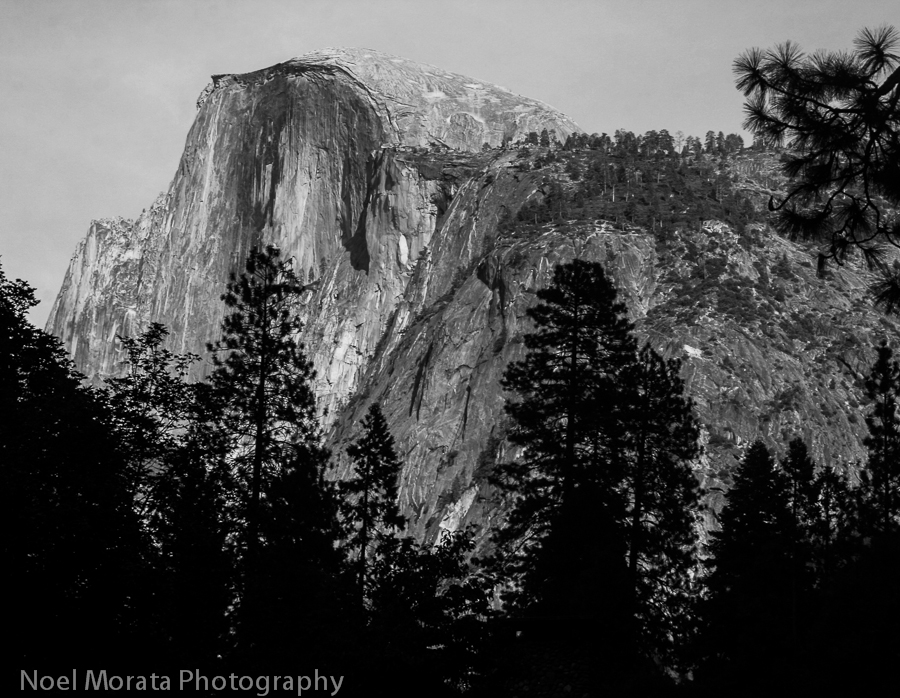

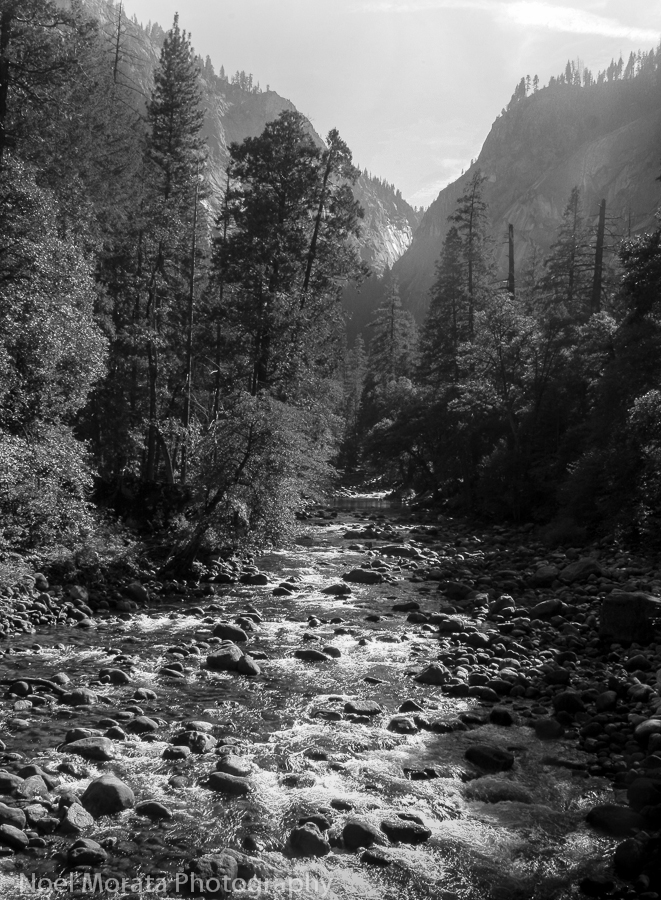
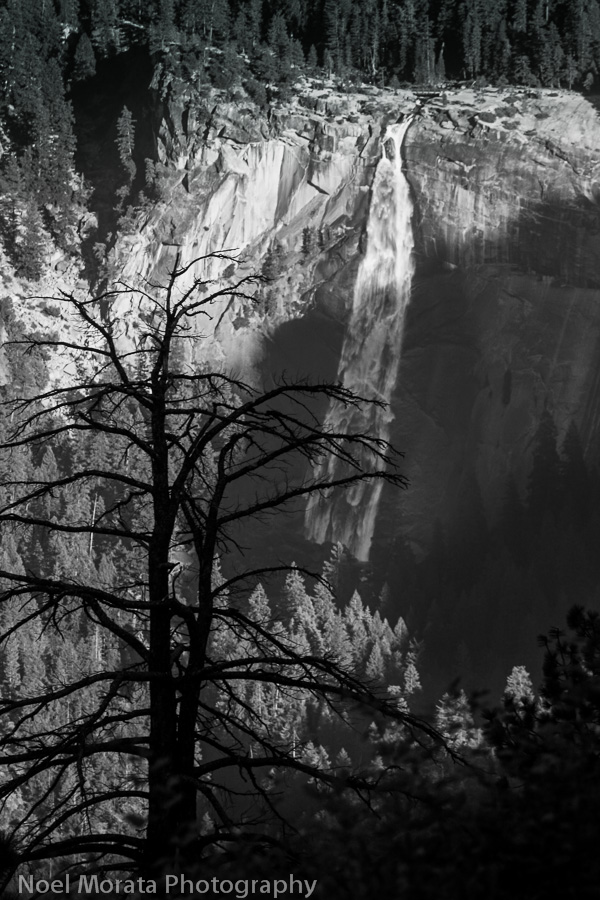
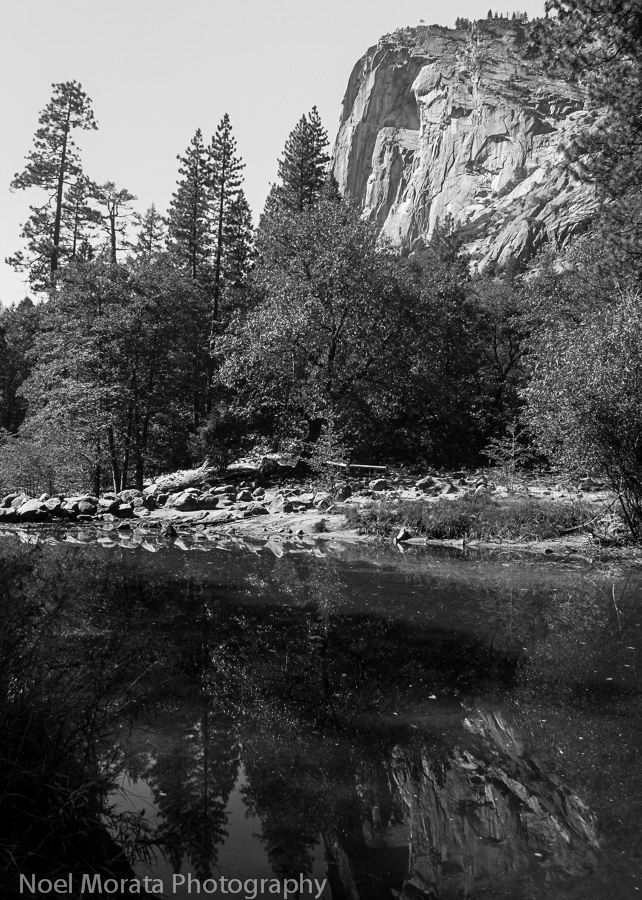


Fantastic images Noel! Beautiful light and shadows. Yosemite is one of the places I’m longing to visit. I’ve always loved the saying, “You don’t take a photography, you make it.” It truly is creating! Inspiring!
These are stunning images. Having seen your photos, I think Yosemite has to be on my bucket list now!
yes definitely put it in your bucket list, it’s amazing!
The B&W highlights the beauty of the area.
Fantastic photos – and I love that they are in B&W. I think the fourth one of the Merced River is my favourite,
I love the pics. Yosemite is one of the last big national parks I have yet to visit, and I can’t wait to see it in person.
Dropping out the color really accentuates the structure of the rocks. I think my favorite photo is of Nevada Falls with the silhouette of the tree in the foreground.
A very inspiring collection of landscapes. Black and white was the perfect choice for landscapes. The images feel timeless because you chose not to include people, cars, boats (which are sometimes used to show perspective). Have you photographed Cappadocia, Turkey?
Hi Bettie, thanks for connecting…that’s interesting because I will be visiting Cappadocia this October, do you have pictures?
Hello there, I visited Yosemite years ago not knowing much about it, the photos by Ansel Adams absolutely blew me away. You’ve really taken me back to that time, many thanks for that and for posting the very lovely and thought-provoking quotes. Pleasure to meet you via Travel Photo Thursday.
Absolutely gorgeous and you captured the beauty of Yosemite so beautifully! Ansel Adams’ images are what inspired me to visit Yosemite. It was the first national park I visited and ignited my desire to visit as many national parks as possible. I enjoy visiting the gallery too every time we go there.
Hi Noel, What a magnificent photos of Yosemite. I also love the Ansel Adams quotes. I like all the photos but the Nevada Fall seemed to hypnotize me.
Absolutely stunning photos! Yosemite is truly magnificent and is a photographer’s paradise.
Love your photos and I was surprised how evocative landscapes can be in black and white. I often seem to go for as much colour as possible, but I can see how foolish I am! Thank you for sharing them. You have a great talent. I also love the quotes … and they brought me to the truth that I think I’ve always known that taking a great photograph is so much more than just pointing and shooting and hoping for the best. Thanks for commenting over at ZigaZag yesterday too 🙂
You’re right, Noel. Ansel Adams was the first thing I thought about when I saw the title of your post.
I love black and white photography, it imbues the subject with such vitality and gravitas, much more than color does.
Thanks for sharing these stunning images. I’ve learned a lot from your posts on Yosemite.
Beautiful! Love the classic feel of black and white, especially at Yosemite. I hope to make it there sometime and I LOVE Ansel Adams!
Beautiful place… I wish to visit someday…
I have never been to Yosemite. Born and raised in California and never been there! Shocking huh? But that will be remedied in October as we have a trip planned to Yosemite. Looking forward to it. It was fun to see your pictures and your mention of Ansel Adams Gallery means we need to check that out as well. I will have to come back and visit your blog more to see what else I need to know before going on our trip.
Linnea
Breathtaking photography. Yosemite is one of the most beautiful places I’ve visited. The air and water are so crisp and clean. Have you photographed the Grand Canyon? I’d love to see your photos if you have. Aloha, Stephanie
Such dramatic views! You were wise to post them in monochrome–that gives them such depth.
Thanks Bettyl,
You are right, it definitely gives them a different feel and depth, appreciate the connection
Yosemite is a classic beauty. It is my dream to visit this place I hope someday I will. Great shots!
Thank you for joining Water World Wednesday
Kim,USA
Okay. Do you feel that you are being haunted by Ansel Adams’ ghost? Just wondering.
Haha, no Marilyn I’m just very appreciative of his work and how much effort it took to get his type of craftsmanship and this was waaaay before computers and nice easy to work with cameras.
Hello, Noel,
Thank you for visiting my blog and your kind comments. I would love to contribute to your meme. Can you please send me the link?
Your images of Yosemite are quite stunning!
Hi Nick,
Here’s is the current one, it runs the week or you can join us for the next one, thanks http://travelphotodiscovery.com/yosemite-history-and-indian-culture-travel-photo-mondays-8/
Hi Noel: Your photographs are stunning. Being born and raised in California, I spent a few weeks every summer in Yosemite. Even as a child and a teenager, I could grasp the beauty there. I have climbed Half Dome and walked under Bridal Veil falls. What memories and great experiences..Thank you..Happy Wednesday..Judy
Aloha Judy,
Thanks for commenting and lucky you for being able to go to Yosemite often, I would go all the time if it was in my back yard, thanks for connecting.
What engaging images!
Hi Irene,
Thanks for the comments on my images, appreciate it.
These black and white images and the Ansel Adams quote reminds me of a print I had years ago of half-dome in b/w. It used to hang in my office…not sure where it is now but I want to go look for it…. Thanks for the memories Noel!
Hi Mary,
isn’t it amazing how some places and images can invoke those special memories, thanks for connecting today.
Just stunning!
Hi Mary,
THanks for connecting and your sweet comment!